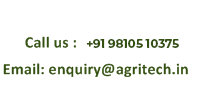CHEMICALS PRESENT IN FRUITS AND VEGETABLES AND THEIR HEALTH EFFECTS
1 . Which chemicals are allowed/banned in Fresh Fruits and Vegetables?
Fruits and vegetables are highly nutritious and form as key food commodity in the human consumption. They are highly perishable due to their low shelf life. These food commodities are reported to be contaminated with toxic and health hazardous chemicals. Chemicals like calcium carbide/ethephon and oxytocin are reportedly being used in fruit and vegetable mandis/farms for artificial ripening of fruits and for increasing the size of fruits and vegetables respectively. Calcium carbide more commonly known as ”masala‘ is a carcinogenic agent and banned under PFA Rules, 1955. Ethephon is a pesticide and so it is not recommended as a ripening enhancer. Oxytocin is a mammalian hormone, used as a drug in veterinary services which is not advised for use in fresh fruits and vegetables.
Rule 44-AA of the PFA Rules, 1955 prohibits the use of carbide gas for ripening of fruits.
Rule 44-AA : Prohibition of use of carbide gas in ripening of fruits:- No person shall sell or offer or expose for sale or have in his premises for the purpose of sale under any description, fruits which have been artificially ripened by use of acetylene gas, commonly known as carbide gas.
Ministry of Agriculture has clarified that the fruits are exposed to ethylene gas (fruit ripening plant hormone) in low concentration of 10-100 ppm exogenously to trigger their ripening. It is considered safe in the concentration varying from 0.001- 0.01% depending upon the crop, variety and maturity. There is no specific provision in PFA for ripening agents.
Many instances have been reported that some unscrupulous elements are following the practise of dipping green vegetables in artificial colours to give them a fresh, attractive and pleasant appearance. PFA prohibits use of colours in fruits and vegetables.
As per rule 48-E of the PFA Rules, 1955, fresh fruits and vegetables shall be free from rotting and also from coating of waxes, mineral oils and colours. However, there is provision for coating fresh fruits with food additive viz. bee wax (white/yellow) camauba wax or shellac wax as glazing agent in accordance with the Good Manufacturing Practice for use of food additives under proper label declaration as defined in sub-rule (Z2) (24) of Rule 42.
2. What are their residue limits?
Bee wax (white and yellow) or camauba wax or shellac wax are permitted to be used in accordance with the Good Manufacturing Practice for use of food additives.
Since use ofcarbide gas is prohibited in ripening of fruits under PFA, no tolerance limit for its residue is permitted.
No tolerance limit for colour and mineral oil on fruits and vegetables has been allowed.
The Maximum Residual Limit (MRL) of pesticide residues are given under PFA Rules, 1955 (Rule 65).
The presence of heavy metal in the food item (fruit and vegetables) shall not exceed the MRL given under PFA Rules, 1955 (Rule 57).
The presence of crop contaminants and naturally occurring toxic substances in fruit and vegetables shall not exceed the maximum limit prescribed under PFA Rules, 1955 (Rule 57A and 57 B)
3- Regulation of Food Law:
Implementation of Prevention of Food Adulteration Act and Rules rests with State/U.T. Governments. The Commissioner Food Safety / Food (Health) Authority of State/U.Ts. have advised to keep strict vigil to check the use of carbide gas and other hazardous chemicals for ripening of fruits and colouring of fruits and vegetables and to take legal action for violation of the provisions of the Act/Rules.
Source: FSSAI website


